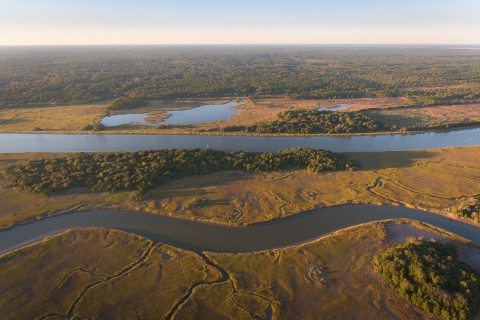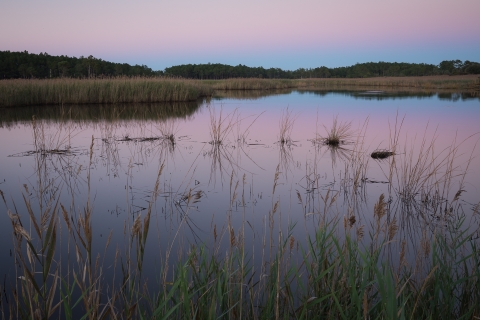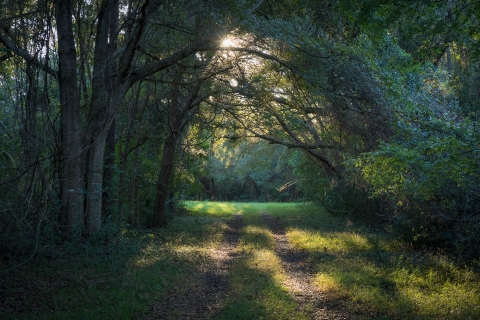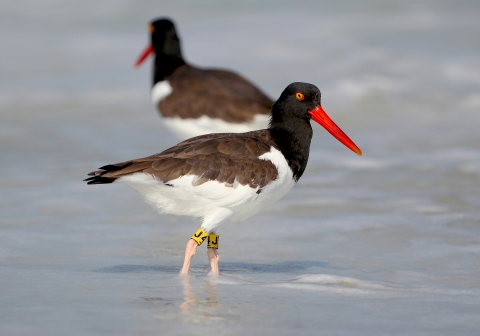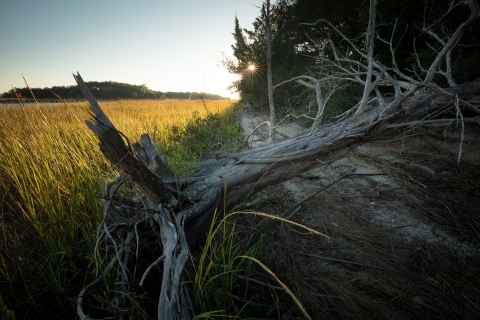Sounding almost like a worn-out country song – buy dirt, ‘cause they’re not making any more of it.
Such is the case with a once-in-a-lifetime opportunity to secure additional land for a jewel of a refuge that is battered by time, tides, and sea level rise. Growing what nature has chipped away at was a precious and priceless opportunity. And fans of Cape Romain National Wildlife Refuge now have more than 400 reasons to celebrate!
On May 14, 2024, the U.S. Fish and Wildlife Service acquired a 420.96-acre tract for the refuge off Dupre Road in McClellanville, South Carolina. The Service paid for it with $4.7 million in Migratory Bird Conservation Fund dollars. Acquired from Nuthatch Stowe, LLC, the property now known as Service Tract 33 includes several types of wetlands (managed, unmanaged, emergent, forested) and uplands. Not only does this acquisition expand the refuge’s ability to manage wintering waterfowl (benefiting all waterbirds), but it also creates new recreational opportunities. Until now, Cape Romain has long been a refuge primarily accessible by boat.
A deal done
Nuthatch Stowe, LLC is part of Terrah Conservation Capital, a company that invests in land conservation in the Carolinas, Georgia, and Tennessee. The company prioritizes projects with the greatest ecological, historical, or recreational outcomes. In an opportunity initiated by the Open Space Institute, Nuthatch Stowe, LLC acquired the 420+ acres from the Stowe-Hunter-Query family in 2020 which had preserved the land for decades as a hunting and fishing retreat.
Over the next four years, Nuthatch Stowe worked with organizations like Ducks Unlimited to make multiple improvements to the property like treating invasive species invasive species
An invasive species is any plant or animal that has spread or been introduced into a new area where they are, or could, cause harm to the environment, economy, or human, animal, or plant health. Their unwelcome presence can destroy ecosystems and cost millions of dollars.
Learn more about invasive species , improving dikes around wetland impoundments, and replacing water control structures to improve waterfowl management. A monumental investment in time and resources while lining things up for a conservation buyer.
In a fast-growing area that was once mostly rural, you can’t put a price tag on something so rare. And patience is part of the process when perpetual protection is the name of the game.
The beat goes on
While there is no debating the value of open space these days, the value to wildlife, wild things, and humans is priceless. A more nature-connected society is a healthier society. That is one thing that everybody can agree on.
As a new owner takes control of this precious piece of land that overlooks the Intracoastal Waterway near McClellanvllle, South Carolina, the ink has dried and Cape Romain NWR has grown. The refuge enters a new phase of resisting, but also accepting the fact that some lands are disappearing on one side but growing on the other. Climate change and rising seas will inevitably eat away at the marshes and barrier islands of this gem of a refuge, but instead of looking in the rearview mirror, the refuge presses on.
And Terrah Conservation Capital will press on, too. There is more land to be protected, already in their sights.
About Cape Romain NWR
Cape Romain NWR was established in 1932 to provide a safe haven for migratory birds. Stretching for 22 miles along the coast of South Carolina - approximately 10 percent of the coastline – its pristine lands and waters include barrier islands with long sandy beaches, dense maritime forests, fresh and brackish water impoundments, emergent salt marshes and intricate coastal waterways. It provides abundant foraging, nesting, and resting areas for over 293 species of birds including seabirds, shorebirds, wading birds, waterfowl, raptors, and neotropical and resident songbirds.
The refuge is home to one of four, large nesting rookeries for brown pelicans, terns, and gulls on the South Carolina coast, and harbors the largest wintering population of American oystercatchers along the Atlantic and Gulf coasts – a high priority species.
Noted as one of 500 Important Bird Areas by the National Audubon Society, the refuge provides habitat for federally listed species like piping plovers, wood storks, and red knots, as well as high priority species like Wilson’s plovers. It is also part of the Cape Romain – Santee Delta Region Western Hemispheric Shorebird Reserve Network of International Importance due to the number of birds that utilize the refuge during migration and for overwintering. Additionally, 29,000 acres of Cape Romain is Class 1 Wilderness with some of the cleanest air on the East Coast.
Wintering waterfowl like scaup, gadwall, widgeon, shovelers, blue and green-winged teal, and ruddy ducks use the impoundments on Cape Romain’s largest barrier island – Bulls Island. Wood ducks and mottled ducks also nest there.
With the addition of the new upland tract, Cape Romain now has two additional impoundments to help manage wintering, migrating, and nesting waterfowl and waterbirds.
And there will be even more birds, and more people to enjoy Cape Romain.
Editor’s note:
The Service has future plans to open accessible roads on the tract for recreation that include birdwatching, photography, hiking, and biking. Additional public access opportunities will be updated at the following link: https://www.fws.gov/refuge/cape-romain
For further information, contact the refuge headquarters at 843-928-3264.



